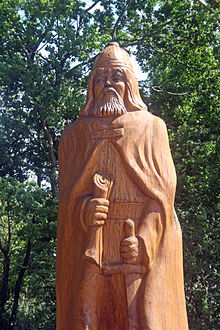Markgrafenheide
|
Markgrafenheide
City of Rostock
Coordinates: 54 ° 11 ′ 37 ″ N , 12 ° 8 ′ 47 ″ E
|
|
|---|---|
| Height : | 3 m above sea level NN |
| Area : | 6.5 km² |
| Residents : | 585 (December 31, 2017) |
| Population density : | 90 inhabitants / km² |
| Incorporation : | December 9, 1924 |
| Postal code : | 18146 |
| Area code : | 0381 |
|
Location of Markgrafenheide in Rostock
|
|
Markgrafenheide is a district of Rostock , recognized Ostseebad (official title: Seebad), and is located in the north of Mecklenburg-Western Pomerania directly on the Baltic Sea .
location
Markgrafenheide is located in the north of the Hanseatic city of Rostock and borders on the Hohe Düne district in the west . There is a car ferry over the Warnow to Warnemünde . The place is about 20 minutes by car from Rostock city center. Markgrafenheide is located directly on the Baltic Sea and is otherwise surrounded by the forest of the Rostock Heath . On the eastern edge of the village runs the Moorgraben , which is connected to the Breitling via the Radelsee .
history


On March 25, 1252, Prince Heinrich Borwin III. , the area around Markgrafenheide, who sold "Rostocker Heide" to the city of Rostock for a payment of 450 marks.
Markgrafenheide was mentioned for the first time in 1586 under the name on the Markgrafenheide . Since when Markgrafenheide can be regarded as a place cannot be determined. The legends about the margrave in a golden coffin, which is supposed to be buried in the heather, as the origin of the name proves, are fictional. The place was a Rostock outpost on the Rostocker Heide . Access to the heather and peat extraction in the moor east of the village were important. The cut peat could be transported in barges through the moat to the Warnow and on to Rostock.
At the turn of the 19th and 20th centuries, bathing began in Markgrafenheide and the number of holidaymakers rose. In 1910, the Warnemünde – Markgrafenheide electric beach tram was opened. Markgrafenheide had become easily accessible from Rostock. This line was shut down in May 1945 and subsequently dismantled.
During the GDR era, the VEB man-made fiber factory “Friedrich Engels” Premnitz built the central pioneer holiday camp “ Alexej Maressjew ” in 1954 . After reunification, it was operated as the "Ostseeferienzentrum Markgrafenheide" and was largely demolished in 2012 in favor of the new "StrandResort Markgrafenheide" building. VEB Energiekombinat Nord opened another company holiday camp - today “Strandnest”.
economy
The economy of Markgrafenheide is shaped by tourism . There are hotels , guest houses , restaurants and a campsite in the village . The largest tourist provider is baltic-Freizeit GmbH. In your holiday park there are not only pitches for tents and mobile homes, but also holiday homes and various catering facilities; also mini golf , squash and tennis courts . The campsite in the holiday park has around 4500 guests per season.
Web links
Individual evidence
- ↑ Statistics office of the city of Rostock: Population with main residence of the Hanseatic and university city of Rostock by district - as of December 31, 2017
- ^ Manfred Labitzke, Willershagen in Mecklenburg , Scheunen-Verlag, ISBN 978-3-938398-63-9


